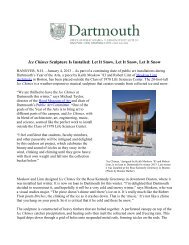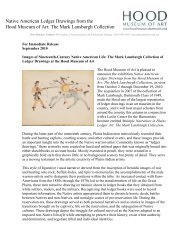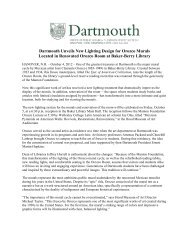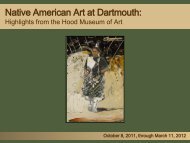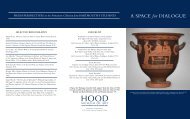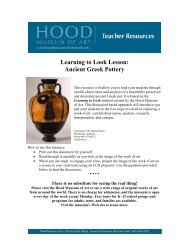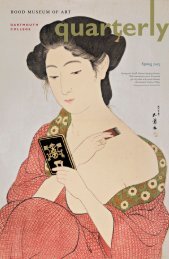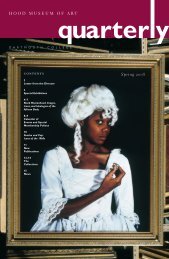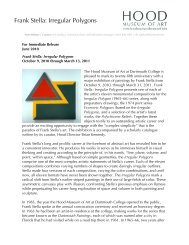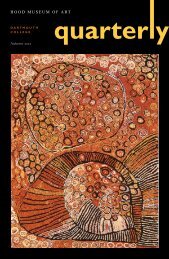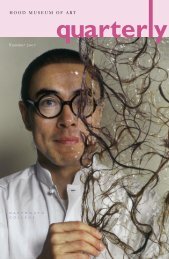The Great Age of English Mezzotints - Hood Museum of Art
The Great Age of English Mezzotints - Hood Museum of Art
The Great Age of English Mezzotints - Hood Museum of Art
- No tags were found...
You also want an ePaper? Increase the reach of your titles
YUMPU automatically turns print PDFs into web optimized ePapers that Google loves.
onward he controlled both the production anddistribution <strong>of</strong> his own prints (Griffiths, “EarlyMezzotint Publishing in England,” p. 251).One way to defer the expense <strong>of</strong> independentlypreparing and issuing prints was to advertisethe future availability <strong>of</strong> particular designsthrough a subscription process, which guaranteedcollectors “the best impressions.” ThomasFrye (1710–1762), an Irish-born painter whotraveled to London in the 1730s and set himselfup as a portrait specialist, used this process tosell “Twelve Mezzotinto Prints . . . drawn fromNature and as large as life” (<strong>The</strong> Public Advertiser,28 April 1760, p. 4). <strong>The</strong> result was a novelseries <strong>of</strong> varied character studies not based onpreexisting paintings and unidentified except fora single self-portrait (fig. 7). <strong>The</strong> striking poses,and Frye’s successful use <strong>of</strong> the dramatic lighteffects that mezzotint could supply, made animmediate impact. One critic praised them in<strong>The</strong> British Magazine in June 1760 (vol. 1, no. 5,p. 135), and Joseph Wright <strong>of</strong> Derby (1734–1797)fig. 7. Thomas Frye, Ipse (Self-Portrait), 1760, included one <strong>of</strong> the heads—the seated youngmezzotint. Purchased through a gift from theman on the far left—in his painting ExperimentCremer Foundation in memory <strong>of</strong> J. <strong>The</strong>odoreCremer; 2006.53.on the Air Pump <strong>of</strong> 1768, which was released as amezzotint the following year (see fig. 9).Awareness <strong>of</strong> Frye’s figures was facilitated bytheir display in 1760 in the first exhibition <strong>of</strong> the Society <strong>of</strong> <strong>Art</strong>ists, in which the series waspresented alongside objects by sixty-seven other painters, sculptors, architects, and designers.From the beginning <strong>of</strong> the newly established event, mezzotint printmakers realized the importance<strong>of</strong> public exhibitions in attracting popular and critical attention. Painters, too, found theshows helpful for promoting themselves and their pictures to a broad audience, especially whenprints after their compositions appeared in the same year or soon afterward. For Joseph Wright<strong>of</strong> Derby, who had already established a reputation as a regional portraitist by the mid-1750s,fourteen <strong>of</strong> the paintings that he exhibited in London between 1765 and 1772 were printed—twelve <strong>of</strong> them as mezzotints. <strong>The</strong> prints served as a lasting record <strong>of</strong> the artist’s most notableexamples <strong>of</strong> his early “candlelight pictures,” which were characterized by spectacular effects <strong>of</strong>natural and artificial light. Most <strong>of</strong> these images were not individual portraits but rather large,multi-figure interior scenes, generally produced on speculation for sale to the general public. Inmany instances the prints were issued within six months after the paintings had been exhibitedand <strong>of</strong>ten praised by critics. In one case, Richard Earlom’s (1743–1822) A Blacksmith’s Shop <strong>of</strong>1771 (fig. 8), the print appeared on the market less than three months after the closing <strong>of</strong> theexhibition in which the painting was displayed. <strong>The</strong> inscription pointed out that the originalhad already been purchased by an eminent patron. Such publicity enhanced the prestige <strong>of</strong>painters, but it also advanced the careers <strong>of</strong> printmakers.8



